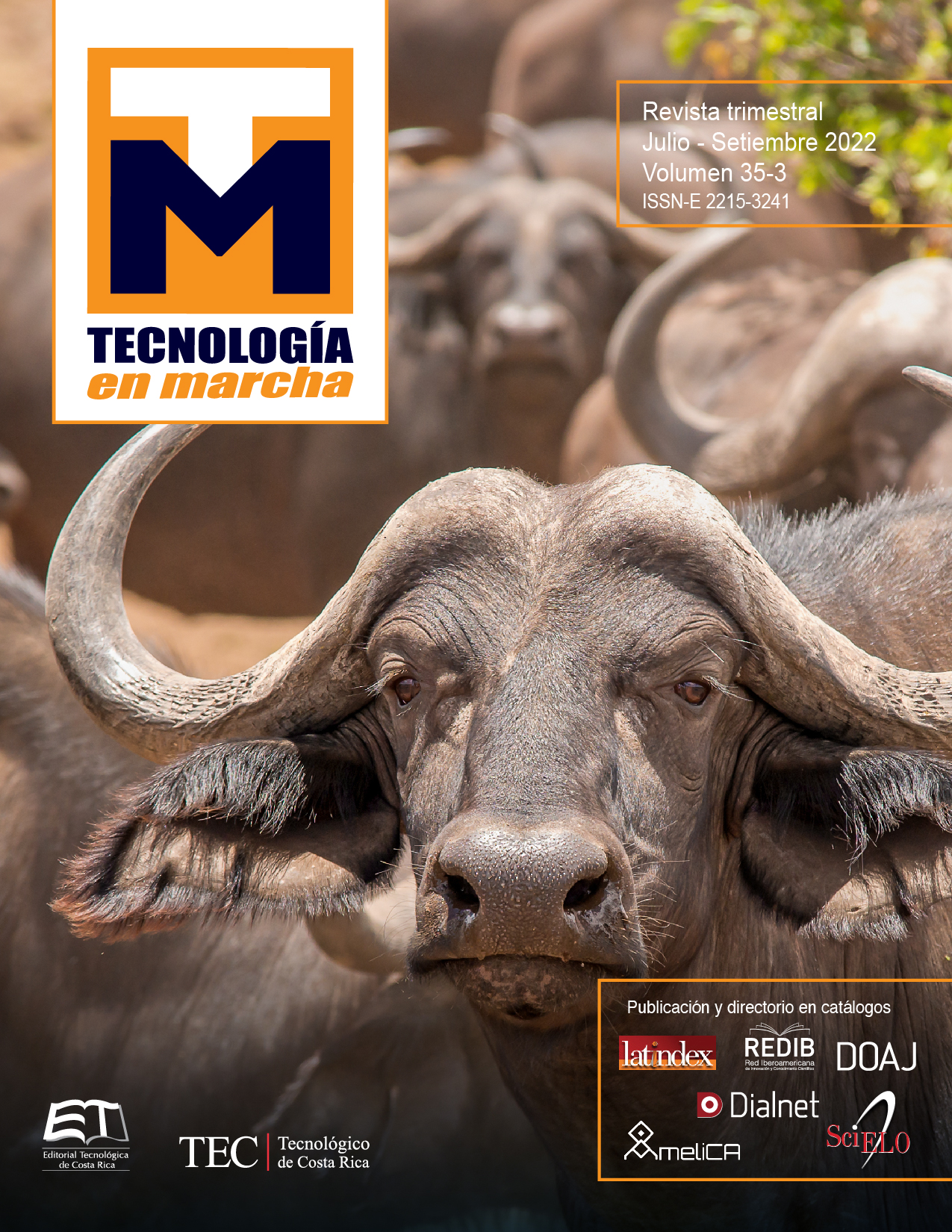Benthic macroinvertebrates community as quality bioindicator of water in a sector of the Chotano river, Perú
Main Article Content
Abstract
Two stations were established in a sector of the Chotano river, with the objective of evaluating the quality of the water, using benthic macroinvertebrates as bioindicators, for which biological indices were used: IBMWP, ETP %, diversity, richness, equity, dominance, density and trophic groups. The collection of macroinvertebrates was carried out using the Surber sampler, in two periods (dry and rainy). In the first season, an average of 710 ind/m2 were collected, classified in 23 taxa of the orders diptera, ephemeroptera and tricoptera, and in the second season 16790 ind/m2 were collected, with 6 taxa of the orders haplotaxide and diptera, the species indicating organic pollution, Chironomus sp, Tubbier sp and Psychoda sp, present mostly in season 2. The highest average indices in season 1 compared to season 2 were IBMWP with 60 points indicating moderately polluted doubtful water quality and 11 points indicating highly polluted critical quality, the diversity of Shannon - Wiener 1,33 and 0,30 indicating waters with limited diversity, the equity of Pielou 0,50 show more stable and 0,20 less stable populations; the lowest indices in station 1 compared to season 2 were, Simpson dominance 0,37 indicator of low dominance and higher diversity and 0,9 indicator of higher dominance, lower diversity and higher organic pollution.
Article Details

This work is licensed under a Creative Commons Attribution-NonCommercial-NoDerivatives 4.0 International License.
Los autores conservan los derechos de autor y ceden a la revista el derecho de la primera publicación y pueda editarlo, reproducirlo, distribuirlo, exhibirlo y comunicarlo en el país y en el extranjero mediante medios impresos y electrónicos. Asimismo, asumen el compromiso sobre cualquier litigio o reclamación relacionada con derechos de propiedad intelectual, exonerando de responsabilidad a la Editorial Tecnológica de Costa Rica. Además, se establece que los autores pueden realizar otros acuerdos contractuales independientes y adicionales para la distribución no exclusiva de la versión del artículo publicado en esta revista (p. ej., incluirlo en un repositorio institucional o publicarlo en un libro) siempre que indiquen claramente que el trabajo se publicó por primera vez en esta revista.
References
G. Roldan, Guía para el estudio de los macroinvertebrados acuáticos del Departamento de Antioquia, Bogotá: Editorial Presencia Ltda; 2019. Available: https://docer.com.ar/doc/11ns1n
A. R. Ladson, L. J. White, J. A. Doolan, B. L. Finlayson y B. T. Hard BT, “Development and testing of an Index of Stream Condition for waterway management in Australia”, Fresh Biol, Vol. 41, no. 2, pp. 453 – 468, 2017. https://doi.org/10.1046/j.1365-2427.1999.00442.x
D. Pham, “Linking Benthic Macroinvertebrates and Physicochemical Variables for Water Quality Assessment in Saigon River and Its Tributaries, Vietnam”, IOP Conf. Ser.: Earth Environ. Sci. 92 012053, 2017. This content was downloaded from IP address 181.64.105.147 on 09/03/2021 at 17:30
A. Barboza, C.S. Silva, S.E. Araujo, T. Lima y I. M. Dantas, “Macroinvertebrados Bentônicos como bioindicadores da qualidade da água em um trecho do rio Apodi-Mossoró”, HOLOS, vol. 32, no. 7, pp. 121 - 132. 2016. DOI: 10.15628/holos.2016.4183
A. Motta, L. Ortega, Y. Niño y N. Aranguren, “Grupos funcionales alimenticios de macroinvertebrados acuáticos en un arroyo tropical (Colombia)”, Rev. U.D.C.A Act. & Div. Cient. vol. 19, no. 2, pp. 425-433, 2017. http://dx.doi.org/10.17268/sci.agropecu.2016.01.04.
L. Rodríguez, P. Ríos, M. Espinoza, P. Cedeño y G. Jiménez, “Caracterización de la calidad de agua mediante macroinvertebrados bentónicos en el río Puyo, en la Amazonía Ecuatoriana”, Hidrobiológica, vol. 26, no. 3, pp. 497-507, 2016.
F. Bernardo, C. Fatima, G. Betiato, G. Pasquali, P. Afonso, y M. Teresinha, “Utilização da estrutura de comunidades de macroinvertebrados bentônicos como indicador de qualidade da água em rios no sul do Brasil”, Ambient. Água, vol. 12, no. 3, pp. 416 – 426, 2017. doi:10.4136/1980-993X
J. Granados-Ramírez, P. Barragán, R. Trejo y M. Martínez, “Macroinvertebrados bentónicos de dos lagos de alta montaña en el estado de Morelos, México”, Intropica, vol. 12, no. 1, pp. 41–53, 2017. https://doi.org/10.21676/23897864.2206
S. López, D. Huertas, A. Jaramillo, D. Calderón y J. Diaz, “Macroinvertebrados acuáticos como indicadores de calidad del agua del río Teusacá (Cundinamarca, Colombia)”, Ingeniería y Desarrollo, vol. 37, no. 2, pp. 269–288, 2019. http://search.ebscohost.com/login.aspx?direct=true&db=zbh&AN=139093499&lang=es&site=ehost-live. Acesso em: 8 mar. 2021.
S. Sabater, J. Donato, A. Giorgi y A. Elosegi, El río como ecosistema. Conceptos y técnicas en ecología fluvial, España: Fundación BBVA; pp. 23-37, 2016.
D. Simeone, CH. Tagliaro y CR. Beasley, “Amazonian freshwater mussel density: A useful indicator of macroinvertebrate assemblage and habitat quality”, Ecol. Indic., vol. 122, p. 107300, 2021. doi: 10.1016/j.ecolind.2020.107300
Ministerio del Ambiente, Métodos de colecta, identificación y análisis de comunidades biológicas: plancton, perifiton, bentos (macroinvertebrados) y necton (peces) en aguas continentales del Perú, Lima: UNMSM, 2017.
M. Custodio y F. Chaname, “Análisis de la biodiversidad de macroinvertebrados bentónicos del río Cunas mediante indicadores ambientales, Junín-Perú”, Scientia Agropecuaria, vol. 7, no 1, pp. 33-44, 2017. https://dx.doi.org/10.17268/sci.agropecu.2016.01.04
A. Palma, Guía para la identificación de invertebrados acuáticos, 2016. Available: http://www2.udec.cl/~lpalma/Palma2013_Guia_identificacion_Macroinvertebrados_preview.pdf
S. Chi, S. Li, S. Chen, M. Chen, J. Zheng y J. Hu, “Temporal variations in macroinvertebrate communities from the tributaries in the Three Gorges Reservoir Catchment, China”, Revista Chilena de Historia Natural. Vol. 90, no. 6, 2017. https://doi.org/10.1186/s40693-017-0069-y
A. Savic, M. Đordevic, M. Juskovic y V. Pesic, “Ecological analysis of macroinvertebrate communities based on functional feeding groups: a case study in southeastern Serbia”, Biologica Nyssana, vol. 8, no. 2, pp. 159-166, 2017.

